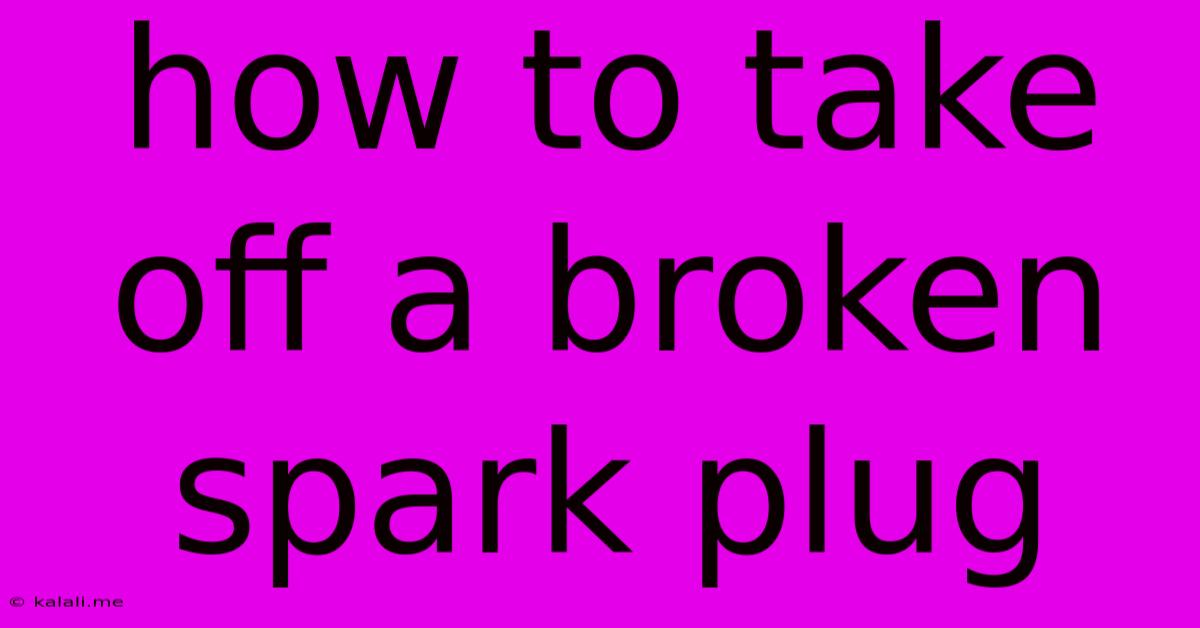How To Take Off A Broken Spark Plug
Kalali
Jun 08, 2025 · 3 min read

Table of Contents
How to Remove a Broken Spark Plug: A Step-by-Step Guide
Removing a broken spark plug can be a frustrating experience, but with the right tools and techniques, you can successfully extract it without causing further damage. This guide provides a comprehensive walkthrough, covering various scenarios and troubleshooting tips. This seemingly simple task requires patience and precision, so let's dive into the process.
Why Spark Plugs Break?
Before we get into the removal process, understanding why spark plugs break is crucial for prevention in the future. Common causes include:
- Over-tightening: Applying excessive force during installation is a leading culprit.
- Corrosion: Rust and corrosion can seize the plug in place.
- Age and Wear: Old, worn-out spark plugs are more prone to breakage.
- Material Fatigue: Repeated thermal cycling can weaken the ceramic insulator.
- Improper Removal Techniques: Using incorrect tools or applying excessive force during removal can lead to breakage.
Tools You'll Need:
Having the right tools at hand is essential for a successful repair. Gather the following:
- Spark Plug Socket: A deep well socket designed specifically for spark plugs is crucial. This ensures a secure grip.
- Wrench: Choose a wrench that fits your spark plug socket securely. A breaker bar can provide extra leverage if needed.
- Penetrating Oil (e.g., PB Blaster): This helps to loosen corroded or seized plugs.
- Needle-Nose Pliers: Useful for retrieving small broken pieces.
- Small Screwdriver or Pick: For carefully maneuvering small parts.
- Shop Rags: For cleaning up debris and oil.
- New Spark Plug: Always replace the broken plug with a new one of the correct type.
- Optional: Spark Plug Extractor Set: For stubborn broken plugs, a specialized extractor set offers various tools for different scenarios.
Step-by-Step Removal Process:
-
Preparation: Disconnect the battery's negative terminal to prevent electrical shorts. Allow the engine to cool completely before starting.
-
Penetrating Oil Application: Generously apply penetrating oil to the broken spark plug, ensuring it seeps into the threads. Allow it to sit for at least 30 minutes (or even overnight for severely corroded plugs).
-
Initial Attempt: Carefully attach the spark plug socket to the broken plug. Use slow, steady pressure to try and loosen it. Avoid using excessive force, as this may worsen the situation.
-
Using an Extractor (If Necessary): If the plug doesn't budge, it's time to utilize a spark plug extractor. These tools vary in design, but the general principle is to grip the remaining portion of the plug and gently twist it counterclockwise. Follow the specific instructions for your chosen extractor. Proceed with extreme caution.
-
Removal of Broken Pieces: Once the main portion is removed, carefully remove any remaining fragments using needle-nose pliers or a small screwdriver. Ensure all pieces are removed to prevent damage to the engine.
-
Clean the Threads: Thoroughly clean the spark plug threads using a shop rag and compressed air (optional). Any remaining debris can interfere with the new spark plug's installation.
-
Install New Spark Plug: Install the new spark plug, tightening it to the manufacturer's specified torque. Over-tightening is a common mistake, leading to future issues.
Troubleshooting Tips:
- Stubborn Plugs: If the plug is extremely stubborn, consider using heat to expand the surrounding metal. This may require a torch, so use extreme caution.
- Damaged Threads: If the threads are damaged, professional help might be required to repair or replace the engine block.
- Extractor Failure: If the extractor fails to grip the plug, you may need to try a different type of extractor or seek professional assistance.
Prevention is Key:
- Regular Maintenance: Regular spark plug replacement according to your vehicle's maintenance schedule is vital.
- Proper Torque: Always tighten spark plugs to the manufacturer's recommended torque specification.
- High-Quality Parts: Use high-quality spark plugs and tools to minimize the risk of breakage.
Removing a broken spark plug requires patience and the right tools. By following these steps and employing the necessary precautions, you can successfully complete this task and avoid further engine damage. Remember to always consult your vehicle's service manual for specific recommendations and torque specifications.
Latest Posts
Latest Posts
-
How To Keep Sugar From Clumping In A Jar
Jun 08, 2025
-
Do Lichess And Chess Com Use The Same Rating System
Jun 08, 2025
-
Wordpress Ask Me To Enter Password Before Wp Admin
Jun 08, 2025
-
What Are Alternative Footwear When Working Out
Jun 08, 2025
-
Best Gta 5 Story Mode Cars
Jun 08, 2025
Related Post
Thank you for visiting our website which covers about How To Take Off A Broken Spark Plug . We hope the information provided has been useful to you. Feel free to contact us if you have any questions or need further assistance. See you next time and don't miss to bookmark.